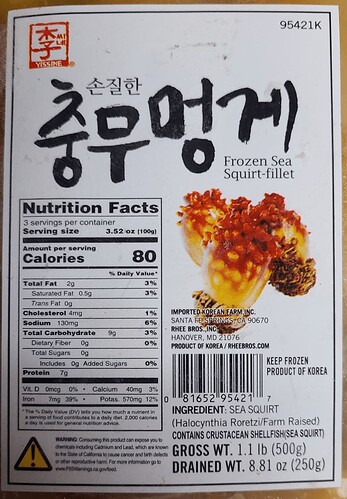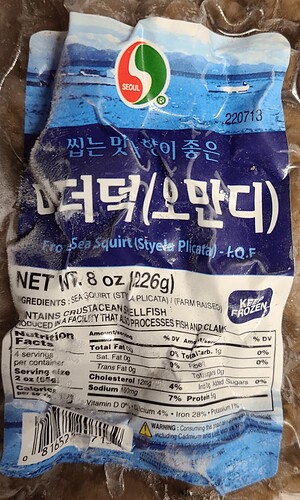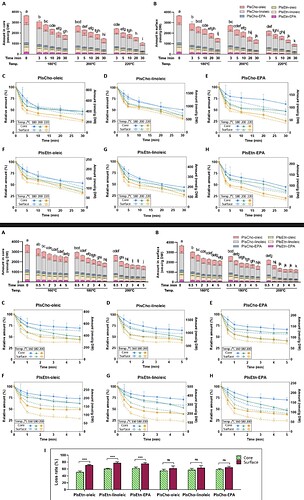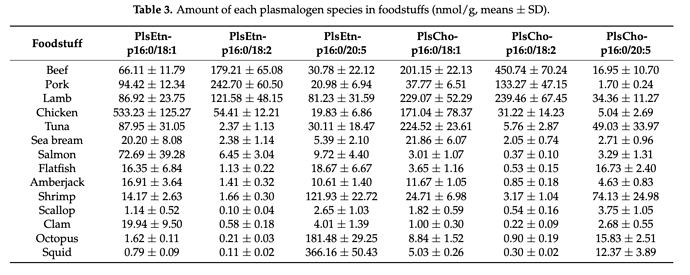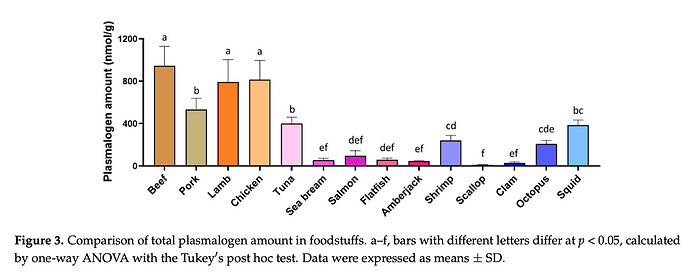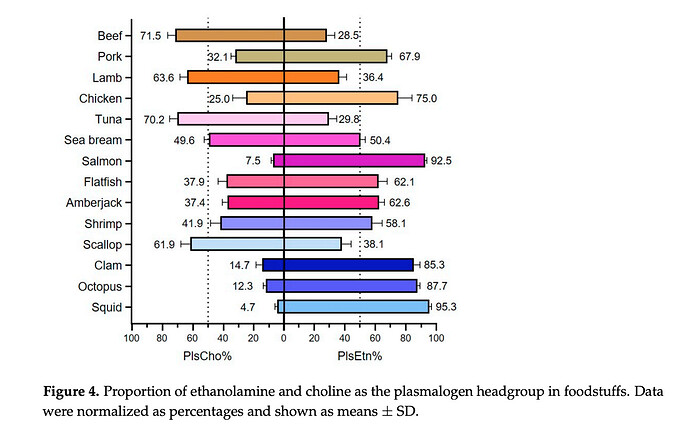" I am the world expert on the biochemical basis of life, disease and death"
Wow, quite a claim and certainly self-serving for someone hawking very expensive supplements. His book, Breaking Alzheimer’s: A 15 Year Crusade to Expose the Cause and Deliver the Cure, appears to be self-published and has a grand total of 8 reviews on Amazon, as of today. And, amazingly they are all 5 stars.
This guy, and I am not dismissing out of hand his findings, has even more conflicts of interest than Dr. David Sinclair.
Maybe his supplements work, but I am not a big fan of such blatant self-promotion and conflict of interest in promoting his “discoveries”.
OK - the adventure begins… found the sea squirts at my local Korean market. Picked up two brands. The “blue and white” package, 226 grams, was $5.99
The red and white package is larger and $12.99
Will report back when I finally cook some of them up:
“farm raised”…you are one brave soul.
But who am I to talk, taking Rapamycin powder from a Chinese supplier. LOL.
Meanwhile my three packs of sea squirts sits untouched in my freezer… I’m a little apprehensive about the taste, and I’m wondering if heat destroys the plasmalogens (need to do more research, could not find much on first pass).
Has anyone checked on this issue?
Chicken ![]()
This was meat plasmalogens various cooking methods, but looks significant. So looks like a a good defrost, and down the hatch!
Not the news I was hoping for ![]()
Another appetizing alternative is lamb brans, lol:
Would be good to see a more comprehensive list of more common fish and seafood that still contain a decent amount, this might be a viable and easier option.
It seems like chicken is the easiest option to get some amount. Does anyone know if plasmalogens are mostly found in chicken protein or fats (i.e. thighs vs breasts)?
The document you post above shows/list “Hare”{I assume wild rabbit] as having a high amount of plasmalogens.
FWIW I tried to download the document from your posted link above, kept downloading corrupt. Went to the main site, located and download a good copy.
Attached is copy I downloaded.
Dawn-Scott-Nelson-talk-Nov-2016 (1).pdf (878.9 KB)
Surprisingly, land based food have high plasmalogen levels. I often eat Masago (Capelin fish roe), those tiny little red eggs they put on sushi, easy to find, not that expensive. Loaded with plasmalogens.
Yes - Sea Squirts are not looking like a good long term solution unless you grew up in Korea and ate it as a child ![]()
And the few times I was offered Sea Cucumber on business trips in China, I should not have passed.
“Sea cucumbers were abundant in ether phospholipids, especially plasmalogens”
The paper cited at the top of this post noted that very specific plasmalogens were probably responsible for the benefit, and land-based animal meat does not contain them much.
Does anyone understand which of these fatty acids are most beneficial?
- 20:5 is EPA
- 22:6 is DHA
- 18:0 is stearic acid
- 18:1 is oleic acid
- 18:2 is linoleic acid
- 16:0 is palmitic acid
Sea food appears to mostly contain #1 and #2 (not surprisingly) but chicken and other meats contain 18:1 and others.
This paper seems to suggest that 18:1, 18:0, and 16:0 are ones frequently found in brains. But it didn’t look into DHA and EPA:
Looking at the table posted on May 11 (top post),blue mussels outperform ascidian (sea squirts) 2 to 1. Mussels are cheaper, and more palatable to the Western consumer.
You can get capsules of New Zealand green lipped mussel if you prefer the supplement route.
That is hilarious.
Clearly I’m deep into this now if I laugh at that. ![]()
ProdromeNeuro is $199, ProdromeGlia is $99. How do you decide which one?
Plasmalogens per se are vital membrane phospholipids in humans. Changes in their homeostatic levels my alter cell membrane properties, thus affecting key signaling pathways that mediate inflammatory cascades and immune responses. The plasmalogen analogs of PAF are also potentially important, considering that anti-PAF activity has strong anti-inflammatory effects. Plasmalogen replacement therapy was further identified as a promising anti-inflammatory strategy allowing for the relief of pathological hallmarks in patients affected by chronic diseases with an inflammatory component. The aim of this Short Review is to highlight the emerging roles and implications of plasmalogens in chronic inflammatory disorders, along with the promising outcomes of plasmalogen replacement therapy for the treatment of various PAF-related chronic inflammatory pathologies.
More new research suggesting benefits for Plasmalogens:
A study of Alzheimer’s patients demonstrated that they had a 70 percent reduction in circulating plasmalogen levels compared to healthy people. This deficit of plasmalogen — which is one of the major components of biological membranes —appears to be specific for Alzheimer’s disease because it was not seen in other neurological conditions.
The earliest loss occurred in the brain’s white matter, which is not associated with dementia onset. Later loss of plasmalogen occurred in the grey matter, which causes the greatest dementia effect. Blood plasmalogen reduction of more than 75 percent was associated with the most decline in mental function.
And:
Marine resources contain unique glycerophospholipid plasmalogens and various valuable nutrients that could be beneficial for the prevention of age-associated diseases. A recent review published in the journal Molecules highlights the biological significance of plasmalogens and their relationship with age-associated diseases.
Paper (open access):
Marine Plasmalogens: A Gift from the Sea with Benefits for Age-Associated Diseases
Aging increases oxidative and inflammatory stress caused by a reduction in metabolism and clearance, thus leading to the development of age-associated diseases. The quality of our daily diet and exercise is important for the prevention of these diseases. Marine resources contain various valuable nutrients, and unique glycerophospholipid plasmalogens are found abundantly in some marine invertebrates, including ascidians. One of the major classes, the ethanolamine class (PlsEtn), exists in a high ratio to phospholipids in the brain and blood, while decreased levels have been reported in patients with age-associated diseases, including Alzheimer’s disease. Animal studies have shown that the administration of marine PlsEtn prepared from marine invertebrates improved PlsEtn levels in the body and alleviated inflammation. Animal and human studies have reported that marine PlsEtn ameliorates cognitive impairment. In this review, we highlight the biological significance, relationships with age-associated diseases, food functions, and healthcare materials of plasmalogens based on recent knowledge and discuss the contribution of marine plasmalogens to health maintenance in aging.
